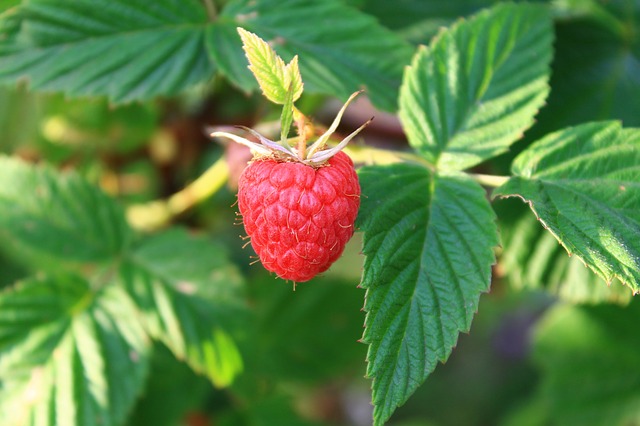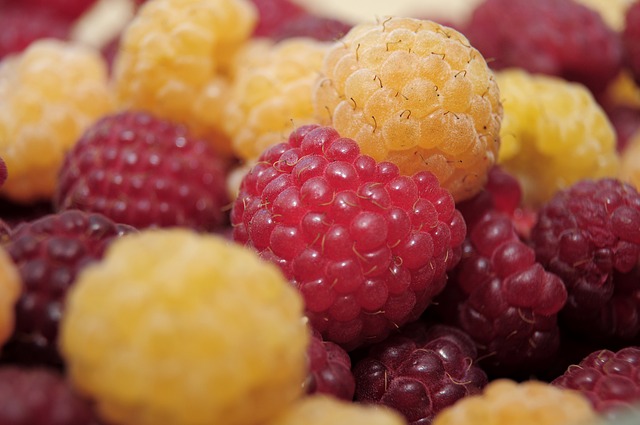Shrub Fruit and Other Small Fruits .
Shrub fruits are a fantastic addition to any garden space. They don't take up a large space, and produce fruit quickly. There are a lot of options to choose from and each one is great in its own way. We would love to be able to tell you what our own favourites are to help you with your decisions, but they are all our favourites! Each of the varieties listed below grows well in our climate, and taste great as well.
- Boyne - An old dependable summer bearing favourite. Produces plentiful bright red fruit. Suckers well. Hardy to Zone 3.
- Double delight - A fall bearing raspberry. Produces large double fruit on primocanes in the fall. Suckers well. Zone 2
- Honeyqueen- A very hardy raspberry with yellow fruit that is very sweet.
- Fallgold - A yellow raspberry with a very sweet flavour.
- Royalty - Large purple raspberry fruit on hardy canes.
_________________________________________________________________________________
A few fun facts about Raspberries!
Summer bearing vs. Autumn bearing Raspberries
Confused about the difference between summer and fall bearing raspberries? Maybe this will help! (or just confuse the subject more)

Raspberry Planting Guide:
Raspberry Planting Guide
Raspberries should be planted in full sun under normal garden conditions. Raspberries prefer a well-drained spot and do best if kept weeded. Some gardeners provide a light straw mulch to help keep the weeds down. Mulch should not be too thick or new canes will be unable to push their way up through it. A couple of inches should do it. Mulching gives a double benefit to your raspberries as it will eventually compost and feed the canes. It is a good idea to add a layer of fresh mulch each year in spring. Even with mulch, weeding is needed to keep running roots like quack grass from taking over. Raspberries will reward your weeding and mulching efforts with taller canes and larger berries.
Raspberries are not heavy feeders, however they enjoy fluffy, well drained, nutritious soil in full sun. How can you tell if your raspberries are begging for a little more fertilizer? If the canes are robust, near to the height described for their cultivar and producing large berries, they are doing fine. If they are shorter than they should be, slowing down on berry production or berries are small, then the canes probably need a good weeding and/or fertilizing.

Did you know?
The yellow coloured Fall Gold raspberries are very sweet with a lower acid level in the fruit. Producing in the fall, they are excellent for all purposes but their sweetness makes them wonderful for fresh eating!
Confused about the difference between just
Summer bearing raspberries like Boyne, Red Bounty and Souris, have three types of canes during their lifecycle:
First year Canes are called Primocanes and do not bloom or bear fruit. These canes grow to their full height in the first year and prepare for fruit production in the second year.
Second Year Canes called Floracanes bloom and bear fruit by mid-summer.
Third Year Canes need to be pruned out to keep the patch airy, clean and disease free. Their productive life is over. But no worries, new canes are emerging every year to replace the old worn out ones!
Summer bearing raspberry plants always have some first year, second year and third year canes growing at any one time, once the plants become established.
______________________________
Fall bearing raspberries :
Fall bearing raspberries like Double Delight, bloom and bear fruit on first year canes called primocanes in the fall.
Once the canes have produced fruit, the canes can be mowed down with a lawnmower for quick, easy maintenance.
However, if the canes happen to not get mowed down, the raspberry plants will produce a second crop in mid-summer of the second year on the floracanes . This is one of the few garden tasks that reward a gardener with two crops for procrastinating and forgetting a clean-up chore! In the third year the old canes need to be pruned out to keep the patch healthy and producing.
It is nice to have fresh raspberries in the fall which is traditionally out of season for raspberries and fall bearing raspberries do this. Here in zone 3b, hard, early frosts sometimes take the fruit before it can ripen. Most years, however, there is enough time for the berries to ripen in the fall.
In the garden, both types of raspberries could be treated in the same way. Both summer bearing and fall bearing could be mowed down with your lawnmower in the fall to avoid hand pruning out dead canes. However with summer bearing canes, be aware that they will not bear fruit the following year, only in the following year will they produce a crop. Another approach to keeping an easy care patch, is to mow down half of your row of raspberries and leave half to grow each year to always have a crop. This, however, means only half of your raspberries will be producing at any one time. You will need twice as many plants to supply your needs. Confused yet?!
Or just decide to prune out old canes by hand, it is not such a difficult chore!
Okay, so here is what we do..... every few years we mow the patch off in the fall after fruit production has ended to keep the patch clean. Why in the fall? Because I find it emotionally difficult to mow off a raspberry that is blooming or producing fruit. And we plant both kinds, summer and fall bearing. Now wasn't that simple and painless? Plant a variety of types and clean up the patch every few years by mowing it off. Or really enjoy pruning raspberries!
Which type of raspberry is best? All of them! Each is unique, with great flavour and productivity. Some are larger or sweeter , but all are good! Plant a selection of varieties and enjoy!
_________________________________________________________________________________
- Polar Jewel - Large sweet fruit. Hardy to zone 2.
- Borealis- Excellent for fresh eating. Hardy to zone 2.
- Honeybee - Developed as a polinator for other varieties. Hardy to zone 2.
- Boreal Beast -Excellent flavour. Hardy to zone 2.
- Aurora
- Boreal Beauty
- Tundra
- Indigo Gem
A thorn-less cross between gooseberries and blackcurrants this hardy shrub grows 6 feet tall. Vitamin c and antioxidants are plentiful in the dark coloured, almost black fruit. Hardy to zone 3.
- Pixwell Gooseberry - Sour green fruit ripen to a cheerful pink/deep burgundy and are delicious for fresh eating and jams. Hardy to zone 2.
- Captivator - Has very few thorns making gooseberry picking much more comfortable! Fruit is red and pear shaped once it has ripened.
- Ben Conan - Grows 3 feet tall, with thorns. Harvest time is earlier than Ben Nevis. Black currants make excellent jelly with a unique flavour and a good wine. Hardy to zone 2.
Red Currant -
- Fruit is good for wines and jellies. Jelly taste is similar to Pincherry . Hardy to zone 2.
- Grows 4-5 feet tall with small black fruit in late summer. Good for sauces or jellies or bird food. Hardy to zone 2.
- For fresh eating or jellies. Beautiful blooms in spring followed by delicious fruit. Hardy to zone 2.
- Askola Sea Buckthorn - Female fruit producing shrub grows to 6 feet. Fruit are yellow Requires pollination by A male shrub like Pollmix Sea Buckthorn. Hardy to zone 2.
- Pollmix Sea Buckthorn - A male pollinator for Askola grows to 6 feet. Does not produce fruit on it's own. Hardy to zone 2.
Cherries
- Evans - A good variety that reliably produces quantities of large, bright red fruit that are ready in August. Excellent for pies, jams, wine and fresh eating. It is less sweet than other varieties but still fine for fresh eating when fully ripe. Hardy to zone 2.
- Crimson Passion - Suitable for fresh eating and preserves. Large fruit with a high sugar content.
- Juliet - A sweet variety that is ready in mid August. Dark red fruit.
- Romeo - A sweet variety that is ready by late August. Dark red fruit.
- Carmine Jewel - Sold Out Fruit colour is dark red and is great for jams, jellies and pies. Hardy to zone 2.
- Valentine -
- Cupid -
- D'artagnan -
Evans Cherries from bloom to picking.
Rhubarb
Plant rhubarb in full sun. Easy to grow, it rewards with decades of fruit.
- Canada Red - A very hardy plant with ruby red stalks. Juicy and flavourful. Zone 2.
- MacDonald- A vigorous grower with bright red stems. Zone 1 (wow, you don't see a zone 1 fruit very often!)
- Strawberry Red- A vigorous grower with bright red stalks.
- German Wine - Also a vigorous grower with dark red stalks. Very productive.
- Valentine - A vigorous grower with few seed stalks that produces early in the season with low-acid stalks. Hardy to zone 2.
Asparagus
Male asparagus, like Millenium, put their energy into making spears instead of producing seed, so they are more productive. It also means that they don't cast seed and spread everywhere like older varieties did but stay where they are planted.
- Millenium - A high yielding male asparagus.
- Martha Washington - An older variety that produces excellent spears and spreads through seed. (Which if you want it to spread and fill out an asparagus bed, that's a good thing!)
Fort Laramie - Firm, bright red ,everbearing fruit. Zone 3.
Kent - June beaering fruit. Large juicy fruit, bright red in colour. Zone 3.
Berries Galore - Day neutral. Very prolific, tasty large fruit. An excellent choice for hanging baskets and containers. Probably won't overwinter in Manitoba but with adequate cover of straw there is a fair chance of survival.
Honeyoye - A June bearing variety with large reliable fruit. Hardy to zone 3.
Eversweet -
Grapes
We offer a selection of prairie hardy grapes that produce delicious fruit.
One of our favourites is Valiant, because of it's taste and dependability. Ask us about it the next time you visit the greenhouse.
- Valiant - A hardy variety that produces blue fruit. Best grown on a fence or trellis. Zone 3
- Beta - Similar to a Concord Grape. Hardy to zone 3
Blueberries
Blueberries are hardy for our climatic zone but they really don't like our soil types. Usually heavy with clay and some areas have sandy soils but all soils in our area have a higher PH than what blueberries prefer. Digging a nursery container into a hole in the ground and filling it with low PH soil mix helps fix the problem. Keep applying acid to the soil mix yearly to keep the soil PH lower.
- Chippewa - Dark blue fruit that ripens mid-summer. Zone 3.